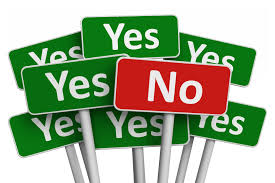A version of this article has also been published at the Globe and Mail.
We’re back to the busy season! Are you back to juggling giant loads? Feeling overwhelmed? Managing busy work (and life) loads calls on many skills and notably, the skill of saying ‘no’.
Do you have trouble saying no? Are you addicted to the yes habit?
If you are a leader, or aspiring to be one, take heed: Too much ‘yay-saying’ can derail your leadership potential.
All photos in this post are courtesy of Pixabay
Of course, it’s important to stretch and do more when it’s called for — and to be agreeable at times. However, an over-active ‘yes habit’ can have significant negative consequences on your career.
Why is it so hard to say no? For many, saying yes, just seems easier. No explanations. Just do it. Agree, and please others. Weighing into this are some misguided beliefs about the repercussions of saying no.
I will disappoint others; I will look like I can’t handle things; I need to show I can do it ALL; I don’t want to rock the boat and be a naysayer; it will be a whole big conversation, etc.
But these are all limiting beliefs and reflect the exact opposite of what a leader should do. Your desire to please others and look good by saying yes can backfire on you. Your untamed ‘yes habit’ can lead to overwhelm, burnout, and serious trust and reputational casualties.
Nobody looks good when the balls come tumbling down.
Nobody looks good when one or more of the balls you are juggling come tumbling down. Overload and overwhelm can lead to missed deadlines, poor quality work, and confused teams. An overwhelmed leader is less apt to have the bandwidth to think critically; to guide strategically; to be generous in their coaching and development of others; and to take a stand and speak up on important issues. All this leads to distrust in your reliability, judgment, and leadership-ability – and burn-out.
It’s the leader’s responsibility to know their own limits (and that of their team); to establish and assert boundaries; to show leadership with their views and voice; and to create the right space to focus on the highest priority work.
Saying no sounds easier said than done sometimes. Today’s ever-changing, high-demand, crazy-paced world of work is challenging. Indeed, learning to professionally say no is part of leadership mastery and a critical skill in the emotionally intelligence leader’s toolkit.
Here are a few ideas to help you tame the ‘yes habit’:
- Recognize and challenge your limiting beliefs: You can’t tame a bad habit until you recognize it. Pay attention to your default ‘yes’ reactions; tune in to become aware of your internal thoughts that prompt you to say yes and try to discern between misguided beliefs and healthy doubts – e.g. healthy doubts might be: I want to say no but don’t know how; I am not sure yet if this is something I can take on and need to reflect on this before responding.
- Stay clear on your priorities: There will always be more work than time and resources. It’s hard to say no to new requests unless you are clear on your priorities. It’s essential for a leader to continually assess the shifting landscape of priorities for themselves and their team. If a request comes in from higher up leadership that will topple an already full load, then initiate a conversation with your leader to establish agreement about reprioritizing and managing expectations in light of new demands.
- Know your limits and set boundaries: A self-aware leader knows their own limits and that of the team and will set boundaries. Pay attention to this and practise communicating boundaries with others as appropriate.
- Practise the ‘pause’: When caught off guard with a request, resist the automatic reaction of saying yes. Take time for diligent reflection and assessment before responding. Even a short pause of a few minutes can make the difference.
- Learn to say no with grace and more ease: Even when you have a justified reason to say no, it can still feel awkward. But if you do this right, the pay-off can result in greater efficacy in your work, your leadership, and results; and garnering more respect. See below for a few more tips on how to do this.
A few tips on how to actually say no and maintain respect and relationships:
- Acknowledge requests before you say no. Thank you for asking me to join this committee. I appreciate it, however, I can’t at this time because…
- Speak from your voice of responsibility: I would like to support you on this but our department has committed to another project with a pressing deadline….
- Make another offer that might be more feasible: While I can’t take this on in full, here’s what I can offer ….would that be of value?
- Express empathy for others: I understand this is important to you and wish I could support you, however…
- Practise and develop the skill over time: Learning to say no is a skill within the spectrum of emotional intelligence. It takes awareness, good judgment, courage, and some Conversational Intelligence® — and practice! The pay off for developing this skill is you will boost your leadership efficacy, confidence, and earn the reputation of a leader that can be counted on.
P.S. there’s lots more on how to tame your ‘yes habit’ in my book: Ease: Manage Overwhelm in Time of Crazy Busy
Eileen Chadnick (@Chadnick) is a certified coach specializing in career, executive and leadership development and a communications pro (20+ years of experience). Principal of Big Cheese Coaching and Chadnick Communications in Toronto, Eileen draws from the disciplines of positivity, neuroscience, emotional intelligence – and Conversational Intelligence®(C‐IQ®) in her work as a coach, consultant, trusted advisor, and facilitator. In addition to authoring the book, Ease: Manage Overwhelm in Times of Crazy Busy, Eileen is also a contributing leadership and careers columnist with the Globe and Mail



0 Comments